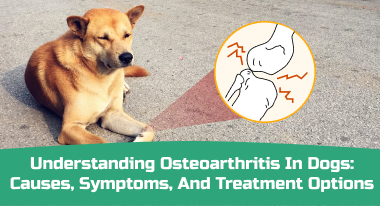Table of Contents
Pet owners share a unique, loving, and caring bond with their canine companions. While you enjoy spending quality moments with your pet, parenting also comes with specific responsibilities. Especially pet dogs often suffer from certain health issues such as arthritis, and to keep these diseases at bay, taking up preventive measures is crucial. Besides, to ensure a healthy life for your furry friends, you as a pet parent should be aware of early detection of such ailments and make arrangements for treatment as soon as possible.
Veterinarians can diagnose the causes and start their treatment at the right time. In this article, let’s understand the meaning of arthritis as a degenerative joint disease in dogs. Also, we have discussed the nook and corners or its diagnosis, prevention, and treatment in the article. Let’s check out:
What Stats Say About Canine Arthritis?
Arthritis is commonly seen among middle and old-aged dogs, but pet dogs of any age can suffer from this disease. The Arthritis Foundation has shown that about 20% of adult or “middle-aged” dogs suffer from the disease, and it is estimated that 90% of older dogs have arthritis in one or more joints.
Besides, dog breeds are also factors to consider in this ailment. A study has shown that 32.25% of Labrador retriever dogs suffer from Osteoarthritis, and 23.43% of German Shepherd dogs recorded to suffer from the ailment. The incidence of Osteoarthritis is more between 5 – 10 years old dogs, i.e., 62.5%.
The same study has shown that bilateral Osteoarthritis of the Coxofemoral joint was noticed by 59.37%, which was followed by unilateral right with 15.62% and unilateral left at 14.06%—extracting data it also has been seen that one in four of 77.2 million pet dogs in the USA is diagnosed with some form of arthritis.
Arthritis in Dogs: Meaning & The Causes
Arthritis in dogs is the condition causing ongoing, long-term, or permanent deterioration of the connective tissues around their joints. It is also known as Osteoarthritis or Degenerative Joint Disease (DJD). Arthritis causes chronic pain in dogs’ joints. They face difficulties in the usual range of motion, such as running, jumping on their favorite sofa set, and even laying down.
They are diverse from arthritis to degenerative or inflammatory arthropathies. The etiology might be of noninflammatory disease conditions composed of degenerative joint disease and Osteoarthritis. It causes degeneration of the articular cartilage, hypertrophy of the bone margin, and visible change in the synovial membrane.
The alteration in the synovial membrane is primarily due to aging or secondary due to developmental diseases. Besides, Osteoarthritis occurs in dogs primarily due to aging but most commonly secondary to hip dysplasia. The senior canines have a greater risk of being affected by Osteoarthritis owing to their wear and tear and delay in regeneration.
The cartilage around a dogs’ joints serves as a resilient, smooth, rubber-like padding. Arthritis causes severe damage to these tissues. The arthritic dogs’ natural movements get adversely affected. This health issue is usually related to the dog’s age. Senior dogs are most commonly affected by such problems.
What Are the Key Causes of Canine Arthritis?
It is challenging for a vet practitioner to analyze different parameters of arthritis in pets, recognize the issue and determine the causes. The dog’s hips, lower back, knees, and wrists are generally affected due to arthritis.
There may be various factors contributing to arthritis and multiple types of this debilitating condition. Let us summarize some significant causes of canine arthritis.
Osteophytes
The most common issue is the deterioration of the cartilage around the dog’s joints. The damage to elastic tissues creating a cushioning effect around the joints may further lead to additional friction in bones and damage to bone tissues. This condition usually occurs with age. The damage to the cushion causes bony growth around the joints, causing pain.
Infection
Inflammatory joint disease is a type of canine arthritis caused due to a bacterial or fungal infection. The infection may be ticks or fleas-borne. Rocky Mountain Spotted Fever can also cause conditions leading to inflammatory joint disease.
Congenital Joint Disorders and Old Injuries
Some long-prevailing joint issues like hip dysplasia and elbow dysplasia may further lead to arthritis. Besides, injuries around the joints may result in arthritis later in senior canines. Therefore, the treatment for injuries should eliminate the damage from the root after-effects.
Repeated Trauma to Joints
If a dog has undergone repeated trauma to joints due to accidents, falls, and other reasons, this may lead to DJD as the dog ages.
Obesity And Metabolic Diseases
The overall weight of the dog also affects the health of its joints. Over-weight or obese pets have more chances to fall prey to joint issues, including arthritis. Metabolic issues like diabetes and Cushing’s disease in dogs cause deterioration of the cartilage around joints, leading to canine arthritis.
What Are The Symptoms of Arthritis in Dogs?
Stiffness and Lameness or Limping
Dogs experience stiffness in joints, causing pain and other problems. Besides, dogs find it difficult to walk and may start limping. This is a significant symptom.
Loss of Appetite
Pet parents may notice the pet is losing appetite. The dogs show disinterest in having their food.
Sudden Abnormal Weight Gain And Lethargy
An abnormal gain in the dog’s weight may signify canine arthritis. Your pet may feel sleepy and tired all the time, as it is difficult for them to move. Pet’s movement is affected due to joint pain. The dogs may be reluctant to walk, run, or climb the stairs.
Behavioral Issues
Pet parents may notice irritability and other behavioral changes in their dogs due to continuous pain in their joints. Besides, you also may witness that if the dog is unusually urinating in the house, it may indicate arthritis.
Muscle Atrophy
It is another significant sign of Arthritis in dogs. They develop muscle atrophy from inactivity. The decreased use of specific muscles causes deterioration over time. If the arthritis is in one or more legs, that particular leg appears thinner than the others.
How Do Vets Diagnose This Disease?
The advancement in veterinary medicine, successful treatment of canine arthritis is possible. However, the line of therapy highly relies on the proper diagnosis of the issue. Veterinarians with experience and expertise can make out the root cause of the issue. Let’s see how veterinarians usually diagnose the problem:
Thorough Physical Examination
A physical examination helps veterinarians to understand the cause and severity of joint pain. The vet recognizes any pain in the joints of the dog and checks its movements. Physical examination provides a primary overview of what is troubling with the dog.
A Dog Having a Checkup on a Veterinary
However, a physical examination can provide some indications that need further in-depth assessment through some tests. A thorough diagnosis requires additional evidence to confirm it is arthritis. If the basic diagnosis indicates arthritis in the pet, the further tests can help vets determine the severity.
Assessment of Medical History
The age, breed, weight, and dog’s physical attributes are some other factors vets consider. Apart from that, a vet asks questions to the particular dog owner targeting the issue.
- What are the symptoms?
- When did they notice the symptoms?
- Are there any noticeable behavioral changes in the dog?
- Did the dog meet with an accident or a fall from height?
- What do the dog owners do for the dog’s weight management? and so on.
Some vets prepare a detailed questionnaire for pet owners. Their answers and the dog’s medical history help a veterinarian get to the root cause of the issue. They design a customized line of treatment for every dog.
X-Rays of Joints
The X-Rays of the dog’s joints help vets determine the severity of the disease. They can glance at the deterioration of cartilage around joints, bony growth causing friction, and other aspects precisely.
Medical Treatments
Treating arthritis is possible through various medical and non-medical therapies. The medical approach to minimize osteoarthritis aims to relieve pain, encourage mobility, repair the cartilage around the joints, and reduce joint deterioration.
Let’s take a look at possible medical treatments to reduce and cure the adverse effects of canine arthritis:
Medication for dog arthritis aims at reducing the symptoms, inflammation, pain, and making the dogs as comfortable as possible. A veterinarian is the right person to prescribe medication depending upon the current condition of a dog.
Here are some common medications prescribed for dog arthritis:
- Analgesics – To reduce pain and increase mobility
- Gabapentin – To treat pain
- Tramadol – Slightly similar to mild opioid medications.
Please note that these medications must be prescribed by a veterinarian, after examining the dog’s condition thoroughly. Specialist orthopedic vets can design the dosage and prescribe proper medication to treat pain and inflammation in an arthritic dog.
Anti-inflammatory Drugs
Glucocorticoids, also known as steroids, have better anti-inflammatory results than NSAIDs. However, designing the dosage and the course is something a veterinarian will decide. This drug is available in the form of injections and tablets.
Nonsteroidal Anti-Inflammatory Drugs (NSAIDs)
Prescription medications like Aspirin and Rimadyl help control inflammation in the dog’s affected joints. However, there may be some side effects of anti-inflammatory drugs. Therefore, vets conduct blood and urine tests to see the dog’s liver and kidneys are functioning correctly, to prevent any possible side effects.
The NSAID options that includes in treating Dog arthritis includes: Deramaxx (deracoxib), EtoGesic (etodolac), Metacam (meloxicam), Previcox (firocoxib), Rimadyl (carprofen), Galliprant (Grapiprant). NSAID Therapy is an excellent way to treat osteoarthritis. However, working with the vet to avoid side effects is essential to minimize the adverse impacts of the drugs.
Laser Treatment
Expert vet orthopedic surgeons conduct class IV therapeutic laser treatment to stimulate blood flow in cartilage tissues. This treatment may provide relief from joint pain and encourage mobility.
Surgery
If the joint deterioration is severe and the dog experiences chronic and severe pain, veterinarians recommend a professional vet orthopedic surgeon. Modern-day vet orthopedic surgeons conduct arthroscopic surgery to remove cartilage debris or repair bone deformity.
Insight On Non-Medical Treatments To Treat Arthritis in Dogs
Many alternative therapies can reduce joint pain due to arthritis and provide significant relief to dogs. Notably, these alternate therapies for osteoarthritis create almost no side effects. These therapies, including acupuncture, are a natural approach to treat osteoarthritis.
A veterinarian specialized in therapy, training for arthritic exercise, and dietary aspects can design and execute these treatments effectively. Here are a few alternative therapies to treat canine osteoarthritis:
Physical Therapy and Exercise
Physical therapy and a low to moderate exercise for 20 minutes, twice a day under the guidance of a specialist vet will be better. Workout boosts muscle mass without disturbing the joints. It improves blood flow and overall activity. Swimming in small sprints is also recommended.
Massage
Easing the muscles and resilient cushion around the affected joint through massage is another way to treat canine arthritis. Certified canine massage therapists are specialized in such kinds of treatments. They exert a specific amount of heat and pressure on the sore joints. They carefully design the treatment for every individual dog.
Nutritional Joint Supplements
Addressing nutritional deficiencies through specially designed joint supplements is another method to prevent and treat canine osteoarthritis. Joint supplements are not prescribed medication. However, they are helpful to balance nutrition like omega 3 fatty acids, glucosamine, chondroitin, Vitamin C, Vitamin D, and more.
The studies show that managing osteoarthritis through supplements is practical. Dog owners must consult their veterinarian before starting any joint supplement. Ensuring the supplement is backed by clinical studies, and approved by concerned authorities is better to avoid any problems.
Acupuncture
This is an alternative method for pain relief in arthritic dogs. The veterinarian places tiny filiform acupuncture needles in predefined points of the dog’s body. Then, a controlled and adjustable electric current passes through the acupuncture needles.
The needles backed by the current stimulate the points and encourage life energy through the points. This method is effective in relieving joint pain and promoting mobility among arthritic dogs.
Ways to Prevent Arthritis in Dogs
- The aspiring pet owners should get X-Rays of the purebred puppy while buying them from a breeder. The X-Rays can let the vets recognize if the growth of the hip bones and other bones is average. This way, pet parents can prevent or delay arthritis in their dogs.
- Pet owners should provide a balanced and nutritious diet to their puppies. Avoiding nutrition deficiency helps prevent arthritis in the long run.
- Dog owners should provide their dogs with a comfortable place to sleep. A proper sleeping posture keeps the joints healthy for years to come.
How To Find The Best Vets
GreatVet has been a preferred online vet discovery platform for all pet parents. We help pet owners like you find the best vets in your area.
We have an adequate database of vet clinics and hospitals operating across 50+ DMA’s and Metros. Along with that, we have a user-friendly mechanism to let you find the best-rated vet clinics and hospitals near you.
Log on to our platform, and follow some simple steps to find vets in your city or metro area:
- Type in the city’s or metro area’s name in the provided search box
- Choose your state in the interactive map by clicking on it
- Click on the list item showing your city or metro area
By following these simple steps, you get a list of vet clinics and hospitals in your area.
To further refine your search, enter your 5-digit zip code in the search box or using our near me page. You will get location-specific information.
Suppose you suspect your dog is showing signs of canine arthritis. In that case, you can search for vet orthopedic surgeons using our specialty filter. You should take your dog to your usual general vet, and the vet will refer you to an orthopedic surgeon. However, if you want a second opinion, please search for a specialist using our platform.
The Takeaway
This article covers basic guidance to dog parents regarding arthritis in dogs. We hope that the causes and symptoms discussed in the article will help dog parents recognize osteoarthritis early. We have tried to cover various methods to diagnose, treat, and prevent this health issue.
Find the best veterinarians near you through our platform – GreatVet. We bridge the gap between pet owners like you and veterinarians so that every pet gets the necessary medical attention at the earliest.
Disclaimer: The content on the site is for educational purposes only, and it does not provide medical advice. The shared information must not be treated as a substitute for or alternative for medical practitioner advice, diagnosis, or treatment. Regarding any concerns about your pet’s health, seeking veterinary guidance is of utmost necessity. Each pet has specific health, fitness & nutrition needs. Do not disregard, avoid or delay pet health-related advice from veterinarians based on reading the information provided on this site.



